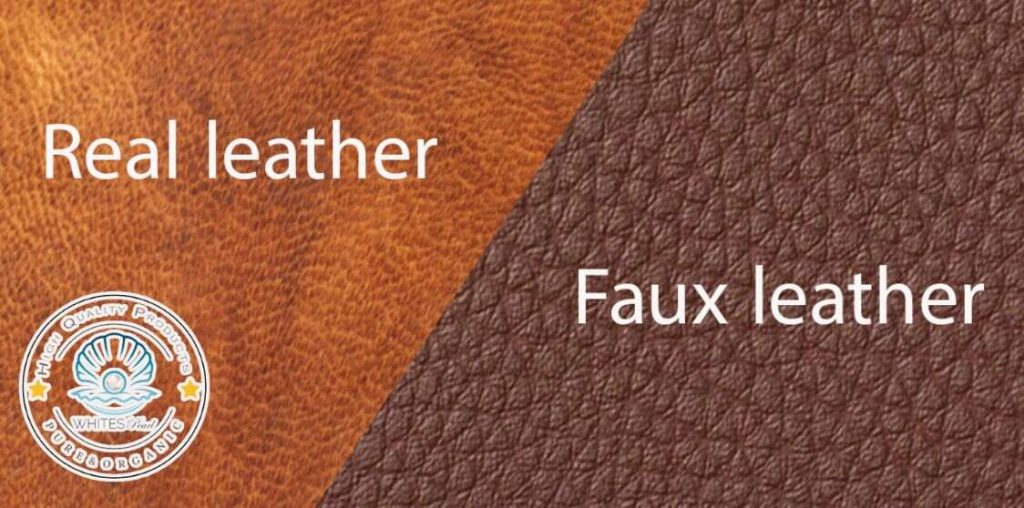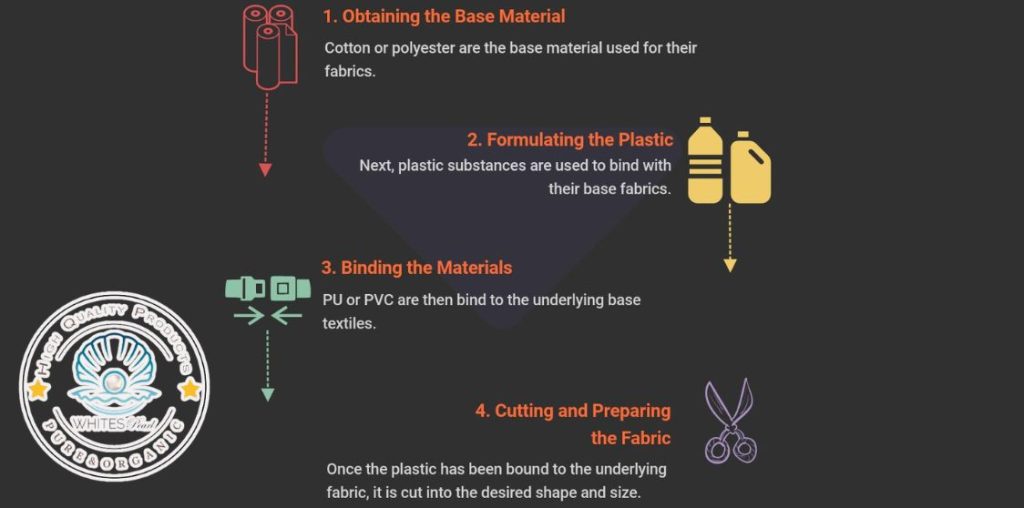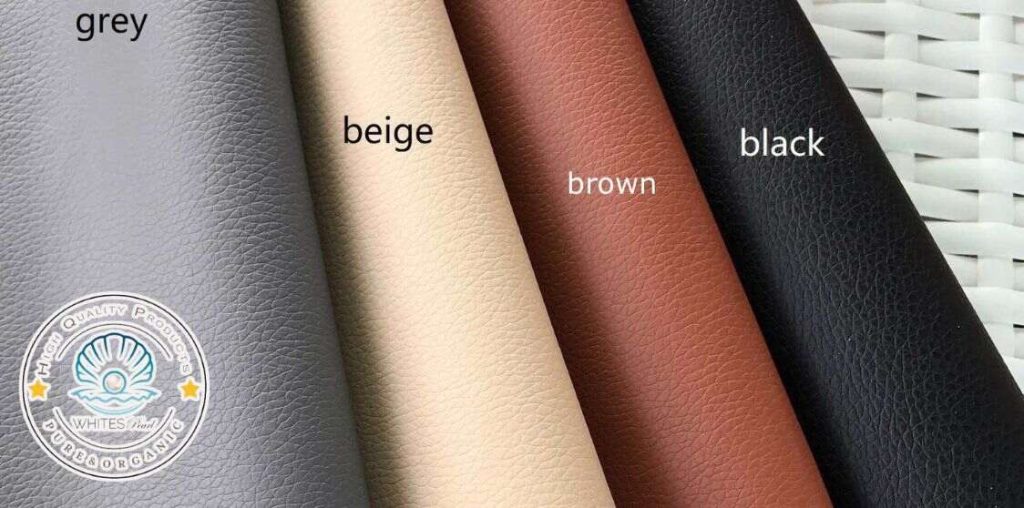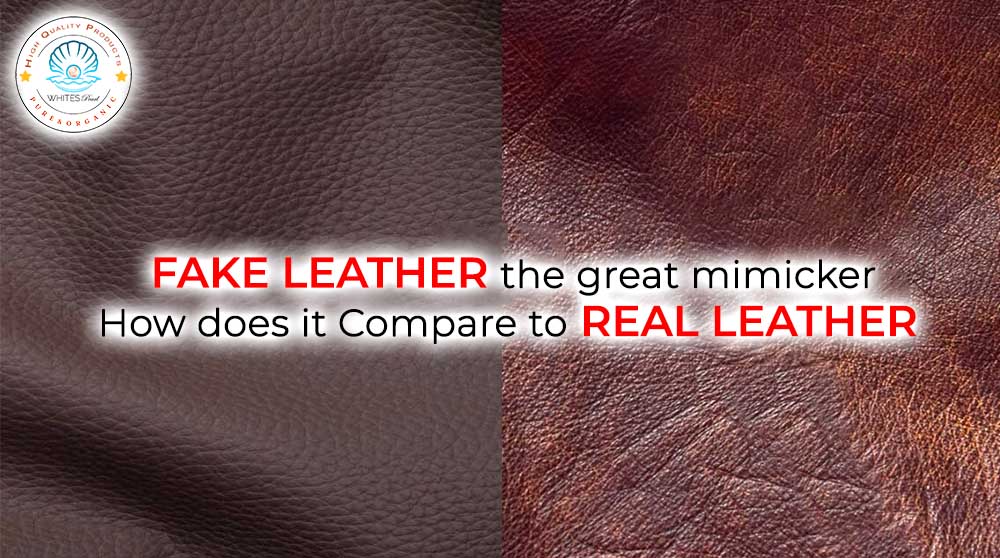
Welcome leather connoisseurs to yet another article where we talk about leather. In this article, however, we will stray a little bit from natural, real leather, and make faux leather, also known as fake leather the topic of our discussion. Fake leather has been gaining traction in the last couple of years. It is not natural, but a man-made product, that has gained much popularity for being a cost-effective, and cruelty-free alternative to real leather.
However, just like many other man-made products, fake leather also had to face its fair share of misconceptions and controversies. In this article, we will shed some light on what fake leather really is and what are its pros and cons as opposed to real leather.
Fake Leather – How does it Compare to Real Leather
Faux Leather – The Mimicker

Faux leather also regarded as fake or synthetic leather is a man-made, artificial material that came into being when many started claiming real leather to be a cruelty-laden elegance. It effortlessly mimics the aesthetic and functional aspects of real leather, however, fails to steal its touch and aroma. One important aspect that we would like to bring to your notice here is that the term “faux leather” is actually an umbrella under which are encompassed a wide variety of fake leathers that are each manufactured differently and possess their own distinct traits and characteristics. Among these types, two of the most common ones are polyvinyl chloride or PVC leather and polyurethane or PU leather.
In recent years, when environmentalists and conservationists rose, natural leather was deemed a cruel material, and hence came forth fake leather that got popularity as it marketed itself as an affordable, cruelty-free leather-like material. However, on the surface, everything seems normal until we dive down deep to understand its true nature. The main problem with fake leather is that even though it is marketed as a low-cost, animal-friendly, leather alternative, it does not possess the same breathability, durability, and aging properties as real leather. The concept of patina does not exist in fake leather, and it is not as aromatic as real leather.
Fake Leather Composition
Fake leather is made up of synthetic materials, unlike real leather which is derived from the hide of animals. Given below are the two main types of fake leather and their composition:
Polyvinyl Chloride Leather
Polyvinyl Chloride or PVC leather is the earliest form of leather however, it is not that much in use today due to the health risks and environmental impacts that are associated with its manufacturing and disposal. During the production of PVC leather, a PVC layer is bonded to a fabric backing. It is then treated with dye, softeners, and several other agents so that it mimics the texture of genuine leather.
Polyurethane Leather
Polyurethane or PU leather is a more modern form of faux leather and is gaining quite a lot of popularity as it poses less threat to the environment as compared to polyvinyl chloride leather. This type of fake leather is produced by applying a layer of polyurethane to a base layer of fiber that is mostly polyester. Afterward, it is treated with heat or embossing in order to give it a texture like that of real leather. PU leather is better than PVC leather because it is softer, more flexible, breathes better, and has a comfortable, quality feel to it.
Even though PU is better than PVC it is vital to note that both of these leathers are made by using petroleum and also undergo chemical processes. Moreover, they both lack the durability, breathability, and natural characteristics possessed by real leather.
Production Process of Fake Leather

The creation of fake leather involves a series of complex chemical processes. Even though the specifics of the manufacturing process are different, depending on the type of leather being manufactured, however, the fundamental process remains the same. The first step in the manufacturing of fake leather involves the creation of a fabric base. This fabric base is mostly composed of polyester. Afterward, the base is coated with either PVC or PU. During the manufacturing of PVC leather, the fabric base is coated with a paste that consists of PVC, plasticizers, and well as other additives. Once the coating process is done the fabric base is heated in order to create a uniform layer.
In the case of polyurethane leather, the fabric base is coated with only a layer of polyurethane, unlike PVC which also requires plasticizers in order to induce flexibility. As PU leather lacks plasticizers, it is considered more evidentially friendly as compared to PVC leather. Afterward, both kinds of leather are treated with dyes, embossing, and other processes that give them the appearance and texture of real leather.
Even though via these processes, manufacturers can create a leather that mimics the looks of real leather, faux leather however lacks the characteristics of real leather that make it elegant, resistant to wear and tear, and also allows it to develop a patina over time. With contestant usage and time, the difference between the two becomes apparent.
Faux Leather -Economical and Versatile Option for Brands
Within the fashion industry, faux leather has become quite famous. There are several reasons, why brands prefer the celebrity mimicker over the real deal, some of them are given below:
Cost-Effective Option – Fake leather is a lot more budget-friendly to produce as compared to real leather. The fact that faux leather requires less processing and less expensive raw materials makes it a cost-effective option for brands and of course customers. lower production costs mean, higher profit margins for brands, and more affordable pricing for customers.
Versatile Material – Faux leather might not come near real leather in terms of quality and durability however, you have to give a point to it for its versatility. Many designers prefer to work with fake leather because it is a versatile material and can be manufactured in a variety of textures, colors, and finishes. Unlike real leather, the texture of which cannot be modified, fake leather can be produced in textures that mimic exotic animal skins. Moreover, there are no ethical issues associated with it, which makes it a popular choice for many designers.
Consistency – Fake leather is void of the natural markings, imperfections, and variations that are found on real leather it carries a more uniform look and feel. Due to its uniform consistency, it is easier for manufacturers to maintain the same appearance and quality across products.
Easy to Care For – Real leather is a lot more difficult to care for as compared to faux leather. Faux leather can be easily cleaned and maintained. All they require is a wipe with a damp cloth and they will be spotless.
Vegan and Environmentally Friendly – As awareness is increasing, so is the conciseness about animal rights and environmental issues. Therefore, people around the world are seeking to invest in products that are cruelty-free and reverentially friendly. Faux leather is one of those products. Real leather is considered unethical and hence is shunned by many around the globe. Faux loathe on the other hand offers an alternative to those customers all the while aligning to their ethical beliefs and values.
However, it would be vital to note here that faux leather comes in many forms, and not all of them are produced equally. Many use plastic materials, and we all know that the biggest foe that the earth is battling these days is plastic pollution. All in all, fake leather is not what it advertises to be and it is best to dive a little deeper into the history of these products if you bear an affinity to the environment.
Fake Leather vs Real Leather – The Ultimate Showdown
| Fake Leather | Real Leather |
| Appearance and Texture: Even though faux leather can mimic the appearance of high-quality real leather; they are still words apart. Faux leather bears a mor uniform appearance and does not age well. Unlike real leather that develops a patina over tie, faux leather remains either unchanged or gets plagues by cracks and peels. | Appearance and Texture: On the other hand, real leather harbors unique patterns and imperfections. It ages gracefully, developing a gorgeous patina overtime. This patina adds to the character and beauty of leather. |
| Durability: The only thing of real leather that faux leather can mimic is its texture and appearance. It does not harbor the top-notch qualities such as durability of real leather. Fake leather does not lats that long and with time begins to peel and crack. | Durability: Real leather on the other hand is quite dyrabke.it can alts for years, decades even if taken care of properly. |
| Breathability: Faux leather is a man-made, plastic product that lacks the breathability of real leather. As it does not breathe, fake leather can prove to be uncomfortable. | Breathability: Being a natural product, real leather can not only breathe, but can also apart to temperature changes, its breathability and adaptability make it a comfortable option for accessories and clothing. |
| Maintenance and Care: As compared to real leather, fake leather is a lot easier to clean and maintain. One can easily clean it by merely wiping its surface with a damp cloth. | Maintenance and Care: Real leather is difficult to care for. It needs specific cleaning products, conditioners, and cleaning technique to maintain its good condition. |
| Environmental Impact: Even though some faux leathers are considered environmentally friendly, their production includes petroleum-based products that can release harmful dioxins in the environment. | Environmental Impact: On the other hand real leather is a natural product and does not mostly involve harmful manufacturing products. It is however considered an unethical material. |
| Cost: As faux leather is a man-made product and does not harbor the top-notch qualities of real leather, it is cheaper. Moreover, it is also not difficult to manufacture and work with which further reduces its price. | Cost: Real leather is a luxury material that harbors luxe qualities, hence its bears a hefty price tag. |
Some Facts About Faux Leather

Market Growth – In the year 2018, the value of the global faux leather market was at $26.3 billion. Moreover, from 2019 to 2025, a compound growth rate of 6.4 percent is expected. This growth in the faux leather market is due to an increasing demand for products that are cruelty-free and animal-friendly.
Dominant Industry – The automotive industry is the one that makes up about half of the consumer percentage of fake leather. This industry uses fake leather to make vehicle interiors, door panels, steering wheel covers, and much more.
Faux Leather Type – As mentioned before, polyurethane leather is the most commonly used faux leather type. This is because it has less impact on the environment as compared to PVC, it bears a striking resemblance to real leather and is flexible.
Regional Usage – In the year 2018, the region that dominated the faux leather market was Asia Pacific. This region accounted for over 40 percent of the global revenue. This dominance is due to the fact that this region is going through rapid urbanization and industrialization.
Impact on the Environment – Even though fake leather is heavily advertised as environmentally friendly, it is important to note that there are different kinds of fake leather that are produced via different means. Some fake leathers like PVC are made from plastic materials that can have an adverse impact on the environment. During the production of PVC, dioxins are released which are a potent carcinogen.
Fake Leather’s Impact on the Fashion Industry
In the last couple of years, maybe more, the fashion industry started shifting towards sustainable and animal-friendly products. Hence, faux leather became the star of the fashion industry, helming the transformative movement. Faux leather is an ethically appealing and cost-efficient alternative to animal-based leather. As more and more people are advocating for animal rights and cruelty-free products, the demand for faux leather is skyrocketing. Let’s take a look at the impact faux leather had on the fashion industry:
Consumer Attitudes
With awareness, comes responsibility. Consumers are getting more and more concerned about the impact their purchases have on the environment and whether they are ethical or not. Their conscious and fashion-savvy buyers have shifted their attention towards faux leather which is deemed as cruelty-free and environmentally friendly.
Regulations
In light of the protests against animal cruelty and environmental degradation, countries and organizations worldwide are now implementing strict regulations that focus on protecting animals and the environment. These regulations have created waves in the fashion industry, prompting the fashion giants to shift their attention from real to faux leather.
Advancements in Technology
Thanks to technological enhancements over the years, the quality of faux leather has seen a drastic improvement. Now modern faux leather can effortlessly mimic the look and feel of real leather which was not the case decades ago. Due to these advancements, faux leather is now considered a worthy material in the fashion industry.
The usage of faux leather in the fashion industry is now widespread, there is no doubt about that. From high-end designer collections to retail lines, fashion is now shifting its attention to fake leather. In fact, brands like Stella McCartney have built their identity around bringing leather-free. This rise in the usage of faux leather is also pushing manufacturers towards exploring more sustainable alternatives like io-based leathers that are composed of mushrooms, fruit waste, and other organic materials.
Even though the world is evolving into a better place for all beings, where we search for ways to accommodate all needs all the while protecting the environment. But fake leather, despite its many merits, is not a perfect solution. Some faux leathers are plastic based, which means that they are nondegradable, filling up the landfills, and contributing to land pollution. However, the continuous efforts of industries and consumers towards a healthy environment and animal cruelty-free world are applaud worthy.
Caring for Fake Leather
Keep it Clean – To keep your fake leather lats for a long time, make sure to clean them regularly. To clean faux leather, take a soft damp cloth, and gently wipe the surface of your faux leather. Keep in mind to never use harsh cleaning products and bleach on fake leather as they can damage it.
Keep it Dry – Even though fake leather is a lot more resistant to water than real leather, it is best to keep it away from liquids and to dry it as soon as spillage occurs. Use a soft cloth and dab at the liquid to dry it.
Don’t Expose to Direct Sunlight – The sun is the biggest foe of fake and real leather alike. Therefore, it is important that you keep your fake leather away from excessive exposure to sunlight. Sunlight can cause faux leather to fade, crack, and peel.
Condition your Leather – Just like real leather, faux leather also needs conditioning and there are specifically designed conditioners available in the market for faux leather. Condition your fake leather on a regular basis to keep it supple and prevent cracking.
Store Properly – When you are not using your faux leather products, make sure to store them in a cool and dry place, away from sunlight. You can cover your couches and other furniture made of faux leather with a cloth and for items like bags and jackets you can use padded hangers.
Cleaning Faux Leather
Fake leather is a lot easier to clean than real leather. Given below are some of the basic steps that you have to follow in order to clean faux leather products:
Dust Your Leather – The first step of cleaning fake leather is to dust it with a soft dry cloth. During this process, try to remove as much dust and dirt as you can so that they don’t get rubbed into the leather during cleaning.
Use a Mild Soap Solution – To clean your fake leather, make a solution of warm water and a few drops of mild dish soap. Keep in mind to avoid harsh chemicals and detergents as they can damage the fake leather.
Clean With a Soft Cloth – Take a clean, soft cloth and dip it into the soap solution that you prepared. Wring out the excess solution and gently wipe the surface of the fake leather. Avoid rubbing and scrubbing as it can damage fake leather.
Rinse and Dry – Once you have wiped the surface with the soapy cloth, wash the cloth, wring it, and then wipe the surface of faux leather again to remove soap residue. Afterward, dry your fake leather with a dry towel.
Special Cleaner – IF after cleaning some stubborn stains remain on the surface of the leather, use a special faux leather cleaner. However, make sure to read the instructions of the manufacturer first and also do a patch test.
Conditioning – Just like real leather, faux leather also requires conditioning after it is cleaned. Use a faux leather condition to maintain the suppleness and shine of the leather. Conditioning fake leather also helps prevent cracking and peeling. To condition faux leather, make sure to use Whites Pearl Leather Conditioner.
Also Read
Leather Patina: Aging Leather Beautifully
Ultimate Guide to Leather Care
Ultimate Guide to 5 Types of Leather


